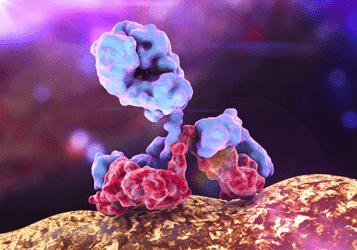- Home
- Products
- Customized ADCs
- ST8SIA1
- Anti-ST8SIA1 (Mitumomab)-MC-Vc-PAB-MMAE ADC
Anti-ST8SIA1 (Mitumomab)-MC-Vc-PAB-MMAE ADC (CAT#: ADC-W-1781)
This ADC product is comprised of an anti-ST8SIA1 monoclonal antibody conjugated via a MC-Vc linker to MMAE. The MMAE is targeted to certain cancers by immunerecognition and delivered into cancer cells via receptor mediated endocytosis. Within the cell, MMAE binds to tubulins, interrupts microtubule dynamics, and subsequently, induces cell death.
- ADC Target
- ADC Antibody
- ADC Linker
- ADC payload drug
- Name
- ST8SIA1
- Alternative Names
- ST8SIA1; ST8 alpha-N-acetyl-neuraminide alpha-2, 8-sialyltransferase 1; sialyltransferase 8 (alpha N acetylneuraminate: alpha 2, 8 sialytransferase, GD3 synthase) A , SIAT8, SIAT8A; alpha-N-acetylneuraminide alpha-2, 8-sialyltransferase; ST8Sia I; ganglioside GD3 synthase; ganglioside GT3 synthase; sialytransferase St8Sia I; alpha-2, 8-sialyltransferase 8A; disialoganglioside (GD3) synthase; ganglioside-specific alpha-2, 8-polysialyltransferase; sialyltransferase 8 (alpha-N-acetylneuraminate: alpha-2, 8-sialytransferase, GD3 synthase) A; sialyltransferase 8A (alpha-N-acetylneuraminate: alpha-2, 8-sialyltransferase, GD3 synthase); GD3S; SIAT8; SIAT8A; SIAT8-A; ST8SiaI;
- Target Entrez Gene ID
- 6489
- Target UniProt ID
- Q92185
- Overview
- Gangliosides are membrane-bound glycosphingolipids containing sialic acid. Ganglioside GD3 is known to be important for cell adhesion and growth of cultured malignant cells. The protein encoded by this gene is a type II membrane protein that catalyzes the transfer of sialic acid from CMP-sialic acid to GM3 to produce gangliosides GD3 and GT3. The encoded protein may be found in the Golgi apparatus and is a member of glycosyltransferase family 29. Alternatively spliced transcript variants have been found for this gene.
- Overview
- Humanized Anti-ST8SIA1 IgG2b-kappa antibody, Mitumomab
- Generic name
- Mitumomab
- Host animal
- Mouse
- Name
- MC-Vc-PAB (maleimidocaproyl-valine-citrulline-p-aminobenzoyloxycarbonyl)
- Description
- Peptide linkers, belonging to Enzymatically cleavable linkers, combine greater systemic stability with rapid enzymatic release of the drug in the target cell. The scission of peptidic bonds relies on lysosomal proteolytic enzymes, which have very low activities in blood due to endogenous inhibitors and the unfavorably high pH value of blood.
- Name
- MMAE
- Description
- Derived from Auristatin,are water-soluble dolastatin analogs of dolastatin 10. Dolastatin 10 belongs to dolastatin family and it can powerfully bind to tubulin, thus inhibiting polymerization mediated through the binding to the vinca alkaloid binding domain, and causes cell to accumulate in metaphase arrest.
For Research Use Only. NOT FOR CLINICAL USE.
Related Products
- Anti-APP (Solanezumab)-MC-Vc-PAB-MMAE ADC (CAT#: ADC-W-701)
- Anti-IGF1R (Robatumumab)-SMCC-DM1 ADC (CAT#: ADC-W-1250)
- Anti-ACVR2B (Bimagrumab)-MC-Vc-PAB-MMAE ADC (CAT#: ADC-W-653)
- Anti-PDGFR (Olaratumab)-MC-Vc-PAB-DMEA-(PEG2)-duocarmycin SA ADC (CAT#: ADC-W-1711)
- Anti-TNFRSF17-PEG4-Mal-DM4 ADC-3 (CAT#: ADC-W-125)
- Anti-C. diff toxin B (Bezlotoxumab)-MC-Vc-PAB-DMEA-(PEG2)-duocarmycin SA ADC (CAT#: ADC-W-2065)
- Anti-KDR (Ramucirumab)-SPDB-DM4 ADC (CAT#: ADC-W-1515)
- Anti-IGHE (Omalizumab)-SMCC-DM1 ADC (CAT#: ADC-W-1286)
- Anti-ICAM1 (Enlimomab)-SPDB-DM4 ADC (CAT#: ADC-W-1209)
- Anti-CD33 (Gemtuzumab)-MC-Vc-PAB-MMAE ADC (CAT#: ADC-W-2540)
Published Data
+ Submit Publications

Scientific Resources
Customer Reviews and FAQs
There are currently no Customer reviews or questions for ADC-W-1781. Click the button above to contact us or submit your feedback about this product.
Quick Links
Other Products
Same Target
Same Linker
Same Payload
| CAT# | Product Name | Linker | Payload |
| ADC-W-1778 | Anti-ST8SIA1 (Mitumomab)-SMCC-DM1 ADC | SMCC (N-succinimidyl 4-(Nmaleimidomethyl)cyclohexane-1-carboxylate) | DM1 (N2'-Deacetyl-N2'-(3-mercapto-1-oxopropyl)maytansine) |
| ADC-W-1780 | Anti-ST8SIA1 (Mitumomab)-MC-MMAF ADC | MC (maleimidocaproyl) | MMAF |
| ADC-W-1779 | Anti-ST8SIA1 (Mitumomab)-SPDB-DM4 ADC | SPDB (N-succinimidyl-4-(2-pyridyldithio)butyrate) | DM4 (N2'-Deacetyl-N2'-(4-mercapto-4-methyl-1-oxopentyl)maytansine) |
| ADC-W-1783 | Anti-ST8SIA1 (Mitumomab)-MC-Vc-PAB-DMEA-(PEG2)-duocarmycin SA ADC | MC-Vc-PAB-DMEA-(PEG2) | duocarmycin SA |
| ADC-W-1782 | Anti-ST8SIA1 (Mitumomab)-MC-Vc-PAB-SN38 ADC | MC-Vc-PAB (maleimidocaproyl-valine-citrulline-p-aminobenzoyloxycarbonyl) | SN-38 (7-ethyl-10-hydroxycamptothecin) |
| CAT# | Product Name | Linker | Payload |
| ADC-W-2592 | Anti-EGFR (Cetuximab)-MC-Vc-PAB-MMAE ADC | MC-Vc-PAB (maleimidocaproyl-valine-citrulline-p-aminobenzoyloxycarbonyl) | MMAE |
| ADC-W-2596 | Anti-ERBB2 (Trastuzumab)-MC-Vc-PAB-SN38 ADC | MC-Vc-PAB (maleimidocaproyl-valine-citrulline-p-aminobenzoyloxycarbonyl) | SN-38 (7-ethyl-10-hydroxycamptothecin) |
| ADC-W-2593 | Anti-EGFR (Cetuximab)-MC-Vc-PAB-SN38 ADC | MC-Vc-PAB (maleimidocaproyl-valine-citrulline-p-aminobenzoyloxycarbonyl) | SN-38 (7-ethyl-10-hydroxycamptothecin) |
| ADC-W-2614 | Anti-MS4A1 (Rituximab)-MC-Vc-PAB-SN38 ADC | MC-Vc-PAB (maleimidocaproyl-valine-citrulline-p-aminobenzoyloxycarbonyl) | SN-38 (7-ethyl-10-hydroxycamptothecin) |
| ADC-W-2601 | Anti-GPNMB (Glembatumumab)-MC-Vc-PAB-MMAE ADC | MC-Vc-PAB (maleimidocaproyl-valine-citrulline-p-aminobenzoyloxycarbonyl) | MMAE |
| CAT# | Product Name | Linker | Payload |
| ADC-W-2551 | Anti-CD74-MC-Vc-PAB-MMAE ADC | MC-Vc-PAB (maleimidocaproyl-valine-citrulline-p-aminobenzoyloxycarbonyl) | MMAE |
| ADC-W-2586 | Anti-EGFR (Zalutumumab)-MC-Vc-PAB-MMAE ADC | MC-Vc-PAB (maleimidocaproyl-valine-citrulline-p-aminobenzoyloxycarbonyl) | MMAE |
| ADC-W-2623 | Anti-NCAM1 (Lorvotuzumab )-MC-Vc-PAB-MMAE ADC | MC-Vc-PAB (maleimidocaproyl-valine-citrulline-p-aminobenzoyloxycarbonyl) | MMAE |
| ADC-W-2574 | Anti-SLC34A2 (Lifastuzumab )-MC-Vc-PAB-MMAE ADC | MC-Vc-PAB (maleimidocaproyl-valine-citrulline-p-aminobenzoyloxycarbonyl) | MMAE |
| ADC-W-2607 | Anti-ITGB3 (Tadocizumab)-MC-Vc-PAB-MMAE ADC | MC-Vc-PAB (maleimidocaproyl-valine-citrulline-p-aminobenzoyloxycarbonyl) | MMAE |
Online Inquiry
Welcome! For price inquiries, please feel free to contact us through the form on the left side. We will get back to you as soon as possible.



